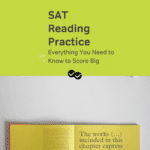So here’s the gist: there will always be on paired passage set on the Redesigned SAT (two passages adding up to the typical single passage length of 500 to 750 words.) What exactly is a paired passage? Well, just as its name implies, it is a set of two passages written on a similar topic. The passages usually do not completely agree with one another, but this doesn’t mean they are always on opposing sides either. More often, the relationship between them will be more subtle. Maybe the second one picks up on a detail in the first and describes it further. Or maybe it provides a personal perspective on a global issue. In any case, these excerpts have been carefully chosen as passages to compare, so you can assume there are going to be several connections between them. Thank you, Captain Obvious, you say? You’re welcome.
On the paired passage, you can expect roughly 4 or 5 questions to be on both passages. The other questions will only pertain to one or the other.
The New SAT’s Favorite Paired Passage Questions
Here’s one of the SAT’s absolute favorite questions to ask about both passages:
- Which choice best describes the relationship between the two passages?
Now you know. And knowing is half the battle. You can expect that almost every single paired passage is going to ask you this question or a variation of it. Sometimes the answer choices will have to do with the different perspectives of the passages (how does each author feel about the topic?). Sometimes they will have to do with the content or structure of the passage (e.g. “Passage 1 takes a high-level view while Passage 2 describes one example in depth”). You should be on high alert to the relationship between the passages as you read, as you are almost guaranteed to see this question.
Other popular SAT Reading paired passage questions include:
- How would the author of Passage 1 respond to the author of Passage 2? (or vice versa)
- On which of the following points would the authors of both passages most likely agree (or disagree)?
Comparison questions might be about a detail in the passages; these tend to be the easiest, although you might have to hunt the answer down. (e.g. “Both the author of Passage 1 and Passage 2 describe pigeons as being…”), but oftentimes they are about higher level issues, so you want to be tracking the main idea of each passage and any similarities and differences between them as you read. If you do this in advance, you will be much more prepared to answer the synthesis questions that follow.
Read One Passage at a Time if you Struggle with Reading
Typically, questions on paired passages will appear in this order: 1. questions only on the first passage 2. questions only on the second passage 3. questions on both passages. If you are not strong on the Reading section, you can chunk your reading by tackling Passage 1 first and answering those questions and then reading Passage 2 and answering those questions before answering questions on both. This will help you retain more information and not get distracted by answer choices that appeared in the other passage.
If You’re Running Out of Time on New SAT Reading
Reading one passage at a time is also a great strategy if you are running out of time, but in this case, start with whichever passage has more questions on it.





